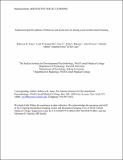Adolescent-specific patterns of behavior and neural activity during social reinforcement learning
Author
Jones, Rebecca M.
Li, Jian
Ruberry, Erika J.
Powers, Alisa
Mehta, Natasha
Dyke, Jonathan
Casey, B. J.
Published Version
https://doi.org/10.3758/s13415-014-0257-zMetadata
Show full item recordCitation
Jones, Rebecca M., Leah H. Somerville, Jian Li, Erika J. Ruberry, Alisa Powers, Natasha Mehta, Jonathan Dyke, and B. J. Casey. 2014. “Adolescent-Specific Patterns of Behavior and Neural Activity During Social Reinforcement Learning.” Cognitive, Affective, & Behavioral Neuroscience (February 19): 1-15.Abstract
Humans are sophisticated social beings. Social cues from others are exceptionally salient, particularly during adolescence. Understanding how adolescents interpret and learn from variable social signals can provide insight into the observed shift in social sensitivity during this period. The current study tested 120 participants between the ages of 8 and 25 years on a social reinforcement learning task where the probability of receiving positive social feedback was parametrically manipulated. Seventy-eight of these participants completed the task during fMRI scanning. Modeling trial-by-trial learning, children and adults showed higher positive learning rates than adolescents, suggesting that adolescents demonstrated less differentiation in their reaction times for peers who provided more positive feedback. Forming expectations about receiving positive social reinforcement correlated with neural activity within the medial prefrontal cortex and ventral striatum across age. Adolescents, unlike children and adults, showed greater insular activity during positive prediction error learning and increased activity in the supplementary motor cortex and the putamen when receiving positive social feedback regardless of the expected outcome, suggesting that peer approval may motivate adolescents towards action. While different amounts of positive social reinforcement enhanced learning in children and adults, all positive social reinforcement equally motivated adolescents. Together, these findings indicate that sensitivity to peer approval during adolescence goes beyond simple reinforcement theory accounts and suggests possible explanations for how peers may motivate adolescent behavior.Terms of Use
This article is made available under the terms and conditions applicable to Open Access Policy Articles, as set forth at http://nrs.harvard.edu/urn-3:HUL.InstRepos:dash.current.terms-of-use#OAPCitable link to this page
http://nrs.harvard.edu/urn-3:HUL.InstRepos:12336386
Collections
- FAS Scholarly Articles [18292]
Contact administrator regarding this item (to report mistakes or request changes)



